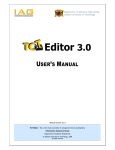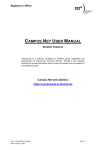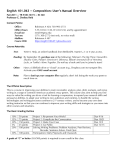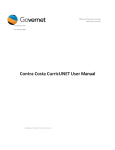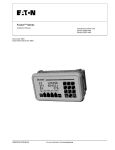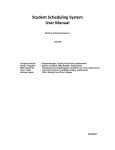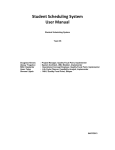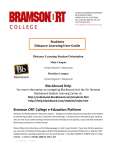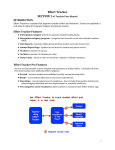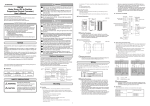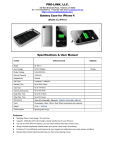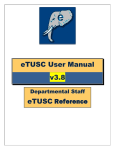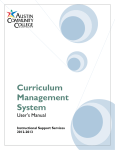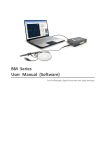Download ELEC 103
Transcript
Syllabus CODE: ELEC 103 TITLE: Electrical Skills and Techniques DIVISION: Science/Technologies DEPARTMENT: Engineering and Technology COURSE DESCRIPTION: ELEC 103 will provide the student new to electronics with some of the basic skills and knowledge important to their success in obtaining an Associate in Applied Science Degree in Electronics Technology, and also important in pursuing a career in Electronics. Calculator usage, electric circuits, graphing, basic test equipment operation, and circuit construction techniques represent some of the areas of proficiency the student is expected to achieve PREREQUISITES: Passing Grade on Basic Skills Math or MATH 025 CREDITS: 4 LECTURE CREDITS: 3 LAB CREDITS: 3 LAB HOURS: As listed in the schedule ADDITIONAL TIME REQUIREMENTS: Additional laboratory time is available as needed. For the current schedule of open lab hours, consult the learning assistant schedule posted on the bulletin board by ATC 106. COLLEGE POLICIES: Please refer to the STUDENT HANDBOOK AND BCC CATALOG for information regarding: ♦ Brookdale’s Academic Integrity Code ♦ Student Conduct Code ♦ Student Grade Appeal Process NOTIFICATION FOR STUDENTS WITH DISABILITIES: Brookdale Community College offers reasonable accommodations and/or services to persons with disabilities. Students with disabilities who wish to self-identify, must contact the Disabilities Services Office at 732-224-2730 or 732-842-4211 (TTY), provide appropriate documentation of the disability, and request specific accommodations or services. If a student qualifies, reasonable accommodations and/or services, which are appropriate for the college level and are recommended in the documentation, can be approved. ADDITIONAL SUPPORT/LABS: Learning assistants are located in ATC 106 Faculty Offices are located in ATC 107 ELEC 103 ELECTRONIC SKILLS AND TECHNIQUES SYLLABUS REQUIRED TEXT AND MATERIALS ELEC 103 Text − Lab Manual online at http://www.brookdalecc.edu/fac/engtech/aandersen//elec103/ Scientific Calculator CORE COMPETENCIES In this course, the student will build electrical circuits and make measurements, read and interpret data, use Excel to enter and chart data, and write laboratory reports according to professional standards. This courses teaches the following Core Competencies: COMMUNICATION SKILLS Students will develop and enhance the skills that allow them to think critically and communicate ideas in a clear, concise manner. Students will: 1.1 Communicate information and ideas clearly and effectively in writing form. 1.2 Communicate information and ideas clearly and effectively in spoken form. 1.5 Demonstrate effective listening skills. 1.6 Demonstrate effective reading skills. CRITICAL THINKING, PROBLEM SOLVING Students will use critical thinking and problem solving skills in analyzing information. Students will: 2.1 Identify a problem and analyze it. 2.2 Create or develop hypotheses. 2.3 Recognize and construct logical forms of argumentation. MATHEMATICAL SKILLS Students will apply appropriate mathematical concepts and operations to interpret data and to solve problems, and understand connections between mathematics and other disciplines. Students will: 4.1 Be able to analyze, discuss and use quantitative information. 4.2 Be able to apply algebraic and/or geometric techniques to analyze and solve mathematical problems. 4.3 Use appropriate problem solving technologies. SCIENTIFIC PERSPECTIVE Students will develop a familiarity with the principles and methods of scientific inquiry, and with its significance to society. Students will: 5.1 Develop appropriate skills in observation and experimentation to solve problems. 5.2 Be able to analyze and interpret scientific data. 5.3 Be able to evaluate and apply appropriate technology. INFORMATION AND TECHNOLOGICAL LITERACY Students will process information including defining, accessing, gathering, organizing, evaluating, and presenting information. The student will be able to: 7.1 Recognize a need for information. 7.3 Assess, use, document and present information objectively and effectively. 7.4 Use appropriate technologies and services to access and process information. Page 1 ELEC 103 ELECTRONIC SKILLS AND TECHNIQUES SYLLABUS STUDENT PERFORMANCE EVALUATION 1. Students must submit their Laboratory Reports for grading no later than two weeks after they are performed. Late work will be penalized 10% per week late. 2. The progress of the student will be evaluated by class participation, graded homework assignments, performance, test grades and on time submission of laboratory experiments. 3. There will be a maximum of five exams, and each will carry equal weight toward the test average. 4. In order to pass the course, the student must submit all mandatory Laboratory Reports, have a passing test average and laboratory average, and submit the course project FINAL GRADE The final grade will be determined by averaging each section and assigning them the following weights: 50% for the Test Average 25% for Laboratory Performance 25% for the Homework 100% Grade for the Course Final Grade Range A 90% to 100% B+ 85% to 89% B 80% to 84% C+ 75% to 79% C 70% to 79% D 65% to 69% F Below 65% To be eligible for an A, Assignment 4 must be performed using Excel. INCOMPLETE It is the student's responsibility to submit all classwork on a timely basis, and it is expected that all course requirements be completed by the last class meeting. In cases of hardship or emergency, your instructor may grant a grade of INC. In order to be considered for the grade INC, the student must have satisfactorily completed 80% of the course, have a passing test average, and must meet with the instructor prior to the last class meeting to discuss this option. Your instructor is under no obligation to grant a INC. WITHDRAWING FROM CLASS Last day to withdraw from a class with a grade W is the 10th week. While a W does not affect your GPA, it may have impact if you are receiving Financial Aid. Before withdrawing from any class, you should consult with your counselor, or a Financial Aid representative. ACADEMIC INTEGRITY Academic integrity is submitting one's own work, and properly acknowledging the work of others. Any violation of this principle constitutes academic dishonesty. Forms of academic dishonesty include: Page 2 ELEC 103 ELECTRONIC SKILLS AND TECHNIQUES SYLLABUS Plagiarism Submitting another's work, in whole or part, as one's own. This includes an examination, a computer program, a laboratory report, or a written assignment. Facilitating Academic Dishonesty Helping another commit an act of dishonesty, such as substituting for an examination or completing an assignment for someone else. Cheating Using or attempting to use unauthorized materials on an examination or assignment, such as using unauthorized texts or notes or improperly obtaining, or attempting to obtain, copies of an examination or answers to an examination. Illegal System Access Altering, transmitting, or permitting unauthorized individuals access to your account, or an attempt to alter or destroy system files on any server or computer. This also includes altering, transmitting, or attempting to alter or transmit academic information or records by unauthorized individuals. Students that participate in dishonest activities ♦ will receive a 0 for that project, examination, or assignment ♦ may be given a grade of F for the course ♦ may be reported to the Dean for disciplinary action. For additional information, refer to the current Brookdale Community College Student Handbook. COURSE SCHEDULE UNIT 1 1 1 2 2 2 3 3 4 4 5 5 6 6 7 WEEK 1 2 3 4 5 6 7 8 9 10 11 12 13 14 15 SUBJECT Resistor color code and schematic diagrams. Reading the analog meter. Proper meter connection for voltage, current, and resistance measurements. Scientific Notation. . Scientific calculator operation . Ohm’s Law and the series circuit . Ohm’s Law and the parallel circuit Ohm’s Law and the series-parallel circuit Graphing. Data Tables and Charting with Excel The sinewave The Oscilloscope. Soldering, Wirewrap techniques, and DIP handling. Soldering Project Electronics Curriculum Information. The course schedule is available at http://www.brookdalecc.edu/fac/engtech/aandersen/elec103/ Page 3 ELEC 103 UNIT 1 Name Of Unit Unit Objective Method Of Evaluation Estimated Time To Achieve UNIT 1 OF 7 Multimeter Usage and Simple Schematics This unit will familiarize the student with the basic operation and application of a Simpson 260 (or equivalent) multimeter. The student will become aware of personal safety and equipment handling precautions, schematic symbols and simple drawings. Class participation, and the grading of a written examination, homework assignments and laboratory reports. 3 Weeks. Learning Objectives At the conclusion of this unit, the student will be able to: 1. demonstrate competency in reading the voltmeter scale of a Simpson 260 multimeter or equivalent, and be able to interpolate between scale divisions. 2. demonstrate the proper use of the parallax mirror on meters so equipped. 3. select and demonstrate the use of the proper range position for voltage measurements. 4. state the hazards involved in making voltage measurements. S/he will be able to state and demonstrate the precautions necessary when measuring unknown voltages, or voltages in excess of 15 Volts. 5. demonstrate the proper way to connect a voltmeter to a circuit and be able to explain the meaning and effect of polarity on voltage measurements. 6. select and demonstrate the use of the proper range position for current measurements. 7. demonstrate the proper connection of the multimeter as an ammeter and explain the meaning and effect of polarity in current measurements. 8. connect two or more batteries in series showing proper regard for battery polarities. 9. draw simple schematic diagrams involving batteries, resistors, voltmeters, and ammeters. 10. state the hazards involved, and the personal safety and equipment precautions necessary when making current measurements. 11. use the resistance ranges of the multimeter and measure the values of unknown resistances. 12. state the three precautions necessary when using an ohmmeter. 13. identify resistors based on the resistor color code. 14. determine the minimum and maximum acceptable values for a resistor based on its tolerance. Recommended Learning Experiences Attend Read Perform Class and participate in the lecture. The Unit One chapter in the Text/Laboratory Manual.. Laboratory Exercises 1.0, 1.1, 1.2, and 1.3. Page 4 ELEC 103 UNIT 2 Name Of Unit Unit Objective Method Of Evaluation Estimated Time To Achieve Learning Objectives UNIT 2 OF 7 Electrical Units, Conventions, and Laws, and Electrical Circuit Mathematics. This unit will familiarize the student with electrical units and conventions, and show the student how to manipulate simple arithmetic and algebraic quantities. It will also demonstrate how to express circuit conditions in terms of simple algebraic equations and electrical variables. Class participation, and the grading of a written examination, homework assignments and laboratory reports. 3 Weeks. At the conclusion of this unit, the student will be able to: 1. state the variable names and meanings of the following algebraic electrical quantities: V, E, I, R, G, Q, C, and T when used in both upper case and lower case letters. 2. define and explain the meaning of the mathematical/electrical terms: variable, constant, inversion, proportion, tolerance. 3. manipulate, add, subtract, multiply, divide, convert to proper, improper, mixed number form, invert, and otherwise work with fractions. 4. use proportions and state them in fractional form, proportionality equations, or percentages. 5. state errors or tolerances as a percentage of expected nominal or other reference value. 6. state the difference between superscript and subscript and give examples of each. 7. write and use a table of powers (exponents) of 10 including the negative powers. 8. name the exponents of 10 and give examples in terms of electrical measurements: 106, 103, 10−3, 10−6, 10−9, 10−12. 9. provide different explanations of the meaning of 10-n where n is any positive integer. 10. multiply and divide numbers containing powers of 10. 11. use subscripts with electrical symbols to differentiate between like types of electrical components or quantities. 12. state the electron flow convention, and apply it to practical situations. 13. correctly label voltage polarity on a circuit drawing given a current. 14. completely and correctly label all components, currents, and voltages with polarities necessary to describe a schematic or its parts. 15. write an algebraic equation using variables, constants, subscripts, and explicit or implied algebraic operators (multiplication, parenthesis). 16. apply the laws of series and parallel circuits in conjunction with Ohm’s Law to write equations describing these circuits. Recommended Learning Experiences Attend Read Turn In Class and participate in the lecture. The Unit Two chapter in the Text/Laboratory Manual. Completed Unit 2 Worksheet from the Text/Laboratory Manual. Page 5 ELEC 103 UNIT 3 Name Of Unit Unit Objective Method Of Evaluation Estimated Time To Achieve UNIT 3 OF 7 Calculator Usage This unit will give the student practice in the use of a scientific calculator as applied to electrical circuit calculations. The student is required to purchase a calculator, preferably an algebraic entry type similar to the TI−35II. Class participation, the grading of a written examination and homework assignments. 2 Weeks. Learning Objectives At the conclusion of this unit, the student will be able to: 1. add, subtract, multiply, and divide a series of numbers, and do simple problems using these operations. 2. round off numbers to a specified precision, both manually and using the calculator (if so equipped). 3. determine the number of significant figures a numbers contains. 4. calculate the reciprocal of a number. 5. raise a number to a positive or negative power. 6. write products or quotients of powers of 10 as single powers of 10 without using the calculator. 7. raise any base to a power (yx function). 8. convert numbers between fixed notation and scientific notation without using a calculator. 9. explain when a calculator will automatically convert to the scientific notation format. 10. explain the difference between scientific notation and engineering notation to represent numbers. 11. convert between fixed, engineering, and scientific notation. 12. perform complex calculations on the calculator observing the proper order of operations. 13. use the memory features of the calculator. 14. use the parenthesis feature of the calculator and/or the hierarchy of operations to perform chain calculations. Recommended Learning Experiences Attend Class and participate in the lecture. Read The Unit Three chapter in the Text/Laboratory Manual and the user manual accompanying the calculator you purchased. Turn In Completed Unit 3 Worksheet from the Text/Laboratory Manual. Page 6 ELEC 103 UNIT 4 Name Of Unit Unit Objective Method Of Evaluation Estimated Time To Achieve UNIT 4 OF 7 Data Collection and Graphing The student will be able to organize and collect data, graphically represent the response of electrical circuits, electrical device characteristics, frequency responses, radiation patterns, and simple mathematical functions using the appropriate graph paper. Class participation, and the grading of a written examination and homework assignments. 2 Weeks. Learning Objectives At the conclusion of this unit, the student will be able to: 1. collect and organize data in tabular form suitable for graphing. 2. describe the difference between a dependent and independent variable, and how they would be plotted in a Cartesian Coordinate System. 3. construct a simple XY graph of the voltage V across a resistor R carrying a current I. 4. define and geometrically explain the meaning of the terms: Slope Intercept Ordinate Abscissa Coordinates Axis Origin Negative Slope Positive Slope Quadrant I, II, III, and IV Quadrants 5. correctly scale an XY coordinate graph with dimensions and units, given the appropriate electrical data such as that calculated for a Sinewave by using the formula: ei = Vp sinθ 7. plot the normalized frequency response of an amplifier on semi−log graph paper given the data table containing the normalized voltage gain and frequencies. Recommended Learning Experiences Class and participate in the lecture. Attend The Unit Four chapter in the Text/Laboratory Manual, Appendix B Read Turn In Assignment 4.1 Compute and tabulate values of the current flowing through a 1000Ω resistor for 2V increments over a range from 0 to 10V. Repeat the calculations for a 2500Ω and a 10000Ω resistor. Plot the data on the same sheet of graph paper using the current in mA as the ordinate and the voltage in V as the abscissa. Assignment 4.2 Compute the value for 10sinθ from 0° to 360° in 10° increments. Plot the waveform on rectangular coordinate graph paper and use a French Curve to connect the points. Assignment 4.3 Compute the value for 10cosθ from 0° to 360° in 10° increments. Plot the waveform on rectangular coordinate graph paper and use a French Curve to connect the points. To be eligible for an A, Assignment 4.1, 4.2, and 4.3 must be performed using Excel. Page 7 ELEC 103 UNIT 5 Name Of Unit Unit Objective Method Of Evaluation Estimated Time To Achieve UNIT 5 OF 7 Analog Instruments This unit will give the student practice in the proper use and application of a wide variety of analog type laboratory instruments such as the Oscilloscope and the audio frequency generator. Class participation, and the grading of a laboratory evaluation demonstrating the ability to use the oscilloscope to measure the peak to peak amplitude, the frequency and period of a sinewave signal. 2 Weeks. Learning Objectives At the conclusion of this unit, the student will be able to: 1. describe the functions and draw a system block diagram for the oscilloscope. 2. describe the purpose of the following oscilloscope controls: a) Vertical Position b) Horizontal position c) Intensity d) Focus e) Vertical Gain f) Vertical Attenuator g) Vertical Polarity h) Sync Selector i) Sweep Selector j) Sweep Vernier k) Horizontal Gain l) Horizontal Attenuator m) Scale Illumination 3. describe how the electron beam may be controlled using an electromagnetic or electrostatic field. 4. describe the operating procedures for an audio generator. 5. use the oscilloscope to view the output of an audio generator. 6. measure the voltage and period of a waveform with an oscilloscope. 7. calculate the frequency of the waveform from the measured period of the waveform. Recommended Learning Experiences Attend Read View Perform Class and participate in the lecture. Various equipment manuals as assigned by your instructor, which are available for use in the Electronics Lab only, and may not be removed from the Laboratory. Read the Unit five Chapter in the Text/Laboratory Manual. Supplementary information may be found in the Bell text. Learning package and Videos on the oscilloscope located in the Electronics Lab. Laboratory Exercise 5. Page 8 ELEC 103 UNIT 6 Name Of Unit Unit Objective Method Of Evaluation Estimated Time To Achieve UNIT 6 OF 7 Circuit Construction Techniques This unit will give the student practice in soldering and wire wrap techniques, and culminate in building a small integrated circuit project. Class participation, and the grading of a written examination, homework assignments and laboratory reports. 2 Weeks Learning Objectives At the conclusion of this unit, the student will be able to: 1. explain the purpose of flux. 2. describe the requirements to make a good solder joint. 3. identify the type of flux used in electrical soldering. 4. identify the metals used in solder. 5. strip wire and prepare component leads for soldering. 6. solder resistors and wires to turret terminals. 7. solder resistors to a Printed Circuit (PC) board. 8. detect good and bad solder joints. 9. unsolder components from terminal posts or PC solder pads. 10. build a project using various electronics components, and solder them to a PC board. 11. use a hand wire wrap tool to make jumper connections between wire wrap terminals. 12. unwrap wire wrapped terminals. 13. Insert and remove an IC (Integrated Circuit) in a DIP (Dual In−line Package) from a socket. Recommended Learning Experiences Attend Read View Perform Turn In Class and participate in the lecture. The Unit Six chapter in the Text/Laboratory Manual. Supplementary information may be found in the Bell text. The one hour video on soldering prior to performing the Laboratory Exercises. Also, have the Laboratory Assistant certify on the Laboratory Cover Sheet that the video was viewed. In addition, you must agree upon a specific soldering project with the Laboratory Assistant before actually starting a project. Insert and remove IC’s using the DIP insertion tool, perform the wire wrapping exercise, perform the soldering exercise by building a project using IC’s and other appropriate parts. The completed soldering test located in chapter six of the Text/Laboratory Manual and the completed soldering project. Page 9 ELEC 103 UNIT 7 Name Of Unit Unit Objective Method Of Evaluation Estimated Time To Achieve UNIT 7 OF 7 The Electronics Curriculum This unit will familiarize the student with the Electronic Engineering Technology Program and aid him/her in planning and scheduling courses. Class participation, and the grading of a written examination, homework assignments and laboratory reports. 1 Week. Learning Objectives At the conclusion of this unit, the student will be able to: 1. state the course codes, titles, and descriptions for all the courses in the Electronic Engineering Technology Curriculum. ELEC 101 Computer Aided Circuit Analysis ELEC 103 Skills and Techniques for Electronics ELEC 111 Electrical Circuits I ELEC 112 Electrical Circuits II ELEC 121 Introduction to Electronic Devices and Circuits ELEC 222 Advanced Electronic Circuits ELEC 241 Introduction to Digital Circuits ELEC 242 Mini/Microcomputer Systems I ELEC 243 Mini/Microcomputer Interfacing ELEC 244 Computer Peripherals and Data Communications ELEC 250 Introduction to Optoelectronics ELEC 295 Special Project in Electronics ELEC 299 Internship in Electronics 2. state the prerequisites for each Electronics course and draw a “prerequisite tree”. 3. state the credit value for each course in Electronics. 4. describe the general requirements to complete an Electronics course, including lab reports, homework assignments, and exams. 5. describe the requirements to obtain a grade of INC for an Electronics course. Recommended Learning Experiences Attend Read Turn In Class and participate in the lecture. The Brookdale Community College Catalog. Especially the sections concerning: a) General and Administrative Sections b) The Electronics Program and Options c) descriptions of Electronic Courses and prerequisites. Unit 7 Chapter in the Text/Laboratory Manual. Prerequisite/Corequisite Homework Assignment Page 10












